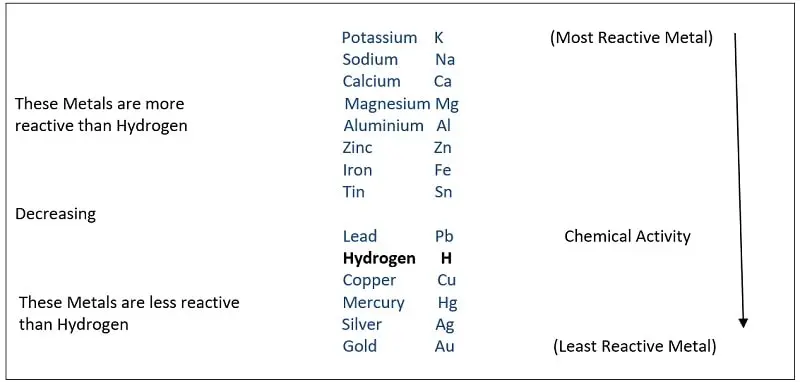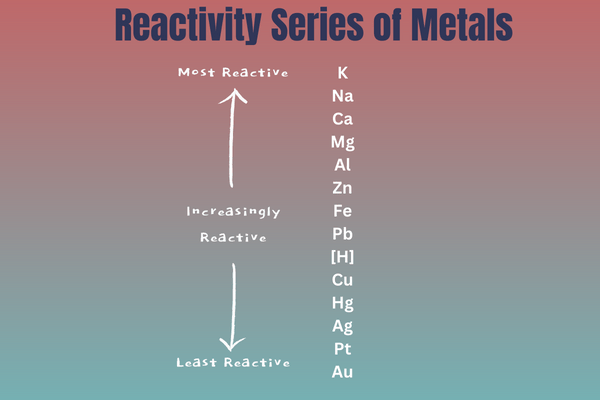Among all the identified Metals and Non-Metals, there are some metals which are more reactive (powerful) than other metals or non-metals. This reactivity of a metal is a property which decides the position of that element in a chemical reaction. In chemical reactions like Displacement Reaction and Double Displacement Reaction, based on the reactivity of an element, elements are placed in a reaction. Hence there is a series of elements consist of metal and non-metal based on their reactivity. This arrangement of metals in a vertical column arranged in a decreasing reactivity order is called Reactivity Series of Metals.
The reactivity series of Metals are as follows:
Potassium (K) is the most reactive metal and hence is placed at the top of the reactivity series. And going down, the chemical reactivity of metals decreases. Gold is the least reactive metal and hence it is found in free state (native state) in nature.
In this table Hydrogen, which is a non-metal and is used to compare with other metals. Hence there can be two categories: one are the metals which are more reactive than Hydrogen and other are the metals which are less reactive than Hydrogen. Also there is one more reason why Hydrogen is placed in the reactivity series of metals is that it can lose electrons to form Positive ions, H+ and can also accept electron to form Negative ions, H–.
Why are some metals highly reactive but some are less reactive?
When we say that some metals like Potassium, Sodium, Calcium, and so on are more reactive that means that they can easily lose electrons to form positive ions and then can rapidly react with other substances to form a reaction. Example: Sodium (Na) atom loses electrons more readily to form Sodium ions (Na+) in a chemical formation of NaCl.
On the other hand, when some metals lose electrons less readily to form positive ions and hence they react slowly with other substances in a reaction. Example: Iron losses electron less readily to form Iron ions (Fe+).
Use of Metals which are more reactive than Hydrogen in a Chemical Reaction:
Some Metals are there like Sodium, Potassium, Calcium, Aluminium, Zinc and so on are more reactive than Hydrogen. This means than these metals can lose electrons and can displace hydrogen in a chemical reaction from any Hydrogen compound. Example:
In this reaction, Sodium (Na) displaces Hydrogen (H) from its compound Sulphuric Acid (H2SO4) and form a new compound Sodium Sulphate (Na2SO4 ) and releases the Hydrogen in a gaseous form. This is possible only because Sodium is more reactive than Hydrogen.
In this reaction, Magnesium (Mg) displaces Hydrogen (H) from its compound Sulphuric Acid (H2SO4) and form a new compound Magnesium Sulphate (MgSO4 ) and releases the Hydrogen in a gaseous form. This is possible only because Magnesium is more reactive than Hydrogen.
In this reaction, Aluminium (Al) displaces Hydrogen (H) from its compound Sulphuric Acid (H2SO4) and form a new compound Aluminium Sulphate (Al2(SO4)3) and releases the Hydrogen in a gaseous form. This is possible only because Sodium is more reactive than Hydrogen.
Use of Metals which are less reactive than Hydrogen in a Chemical Reaction:
Some Metals are there like Copper, Mercury, Silver and so on are less reactive than Hydrogen. This means than these metals cannot readily lose electrons and cannot displace hydrogen in a chemical reaction from any Hydrogen compound. Example:
In this reaction, Copper (Cu) cannot displace Hydrogen from its compound Hydrochloric Acid (HCl) and hence there is no occured reaction.
- Similarly Gold and Silver are also less reactive than Hydrogen and hence cannot displace it from its compound like dilute Hydrochloric acid (HCl) and dilute Sulphuric acid (H2SO4 ).But there is a solution named Aqua Regia, which is a freshly prepared mixture of concentrated Nitric Acid (HNO3) and concentrated Hydrochloric Acid (HCl) in the ratio of 1:3 that can dissolve even gold and platinum metals.
Uses of Reactivity Series & Reaction:
The entire concept of chemical equation and reaction between compounds is based on this reactivity series. Because of this series, it is understood that which metal is can displace which metal and which is more reactive and which is less reactive. Some of the uses of reactivity series are:
- Reactivity is important to understand the Displacement reaction and how elements can displace other elements to form new products. Example:
In this reaction, Iron displaces Copper from its compound Copper sulphate(CuSO4) and forms a new compound Iron Sulphate(FeSO4 ). This is possible because Iron is more reactive than Copper.
In this reaction, Zinc displaces Copper from its compound Copper sulphate(CuSO4) and forms a new compound Zinc Sulphate(ZnSO4 ). This is possible because Iron is more reactive than Copper.
- Reactivity is important to understand the Double Displacement reaction and how elements can displace other elements to form new products. Example:
- Reactivity is important in Redox reactions to know which element will oxidise and which will reduce according to their reactivity. Example:
In this reaction, Manganese from Manganese dioxide (MnO2) displaces Hydrogen from HCl and form Manganese dichloride (MnCl2) and releases Chloride and water.
Reactivity series is an important concept to understand the chemical nature and chemical reactivity of metals and non-metals in a reaction. This helps to know about the reactivity and also about its everyday applications. Like which object has to be placed with which object, for example: it is understand that sour items like curd or pickles are not stored in metal container as the acid present in curd will react with the metal like iron, aluminium, copper and so on.
Hence it is important to be aware of this reactivity series while understand metals and non-metals and their related concepts.

Rahul Kumar is a passionate educator, writer, and subject matter expert in the field of education and professional development. As an author on CoursesXpert, Rahul Kumar’s articles cover a wide range of topics, from various courses, educational and career guidance.













